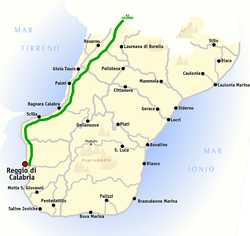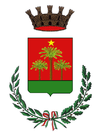Gioia Tauro
| Gioia Tauro | ||
|---|---|---|
| Comune | ||
| Città di Gioia Tauro | ||

Seaport of Gioia Tauro
|
||
|
||
 Map of the province of Reggio Calabria, with Gioia Tauro located to the north at the A3 motorway (A3 depicted in green). |
||
| Location of Gioia Tauro in Italy | ||
| Coordinates: 38°26′N 15°54′E / 38.433°N 15.900°E | ||
| Country | Italy | |
| Region | Calabria | |
| Province / Metropolitan city | Reggio Calabria (RC) | |
| Government | ||
| • Mayor | Giuseppe Pedá | |
| Area | ||
| • Total | 38 km2 (15 sq mi) | |
| Population (November 2012) | ||
| • Total | 19,227 | |
| • Density | 510/km2 (1,300/sq mi) | |
| Demonym(s) | Gioiesi | |
| Time zone | CET (UTC+1) | |
| • Summer (DST) | CEST (UTC+2) | |
| Postal code | 89013 | |
| Dialing code | 0966 | |
| Patron saint | St. Hyppolite | |
| Saint day | August 13 | |
| Website | Official website | |
Gioia Tauro is a comune (municipality) in the province of Reggio Calabria, in Calabria (Italy), on the Tyrrhenian coast. It has an important port, situated along the route connecting Suez to Gibraltar, one of the busiest maritime corridors in the world.
Gioia Tauro has been continuously inhabited for more than 2500 years. From about 400 BC or so it was inhabited by Greek colonists who called it Matauros or Metauros. It was one of the smaller ancient Greek centers among the settlements in Southern Italy (Magna Graecia). The ancient poet Stesichorus is said to have been born there. The remains are a little further inland in the old town of Gioia Tauro on a rise overlooking the Tyrrhenian Sea.
In the 1970s, Gioia Tauro was the main centre for industrial development in Southern Italy, following a burst of violence in Reggio Calabria in 1970, signaling frustration over the central government's neglect of the region. The construction of a large steel plant and port facility was meant to bring income and jobs to Calabria. Until then Gioia Tauro had been a productive and beautiful agricultural area. Profitable farms and olive groves were expropriated and demolished.
The 'Ndrangheta, a Mafia-type criminal organisation based in Calabria, and in particular the Piromalli clan, exploited the construction of the steelworks until the project was abandoned in 1979, when the crisis in the steel industry could no longer be ignored and the government decided there was no economic base for it. In the meantime some 1,000 people were killed in conflicts over construction contracts. For a while the homicide rate of Gioia Tauro, with a population of about 17,000 at the time, was higher than that of New York City.
Following this, a proposed electrical energy power station was never built, due to environmental problems. Gioia Tauro became an example of the failure that characterized much of the development of Italy's South as "industrialisation without development."
...
Wikipedia


